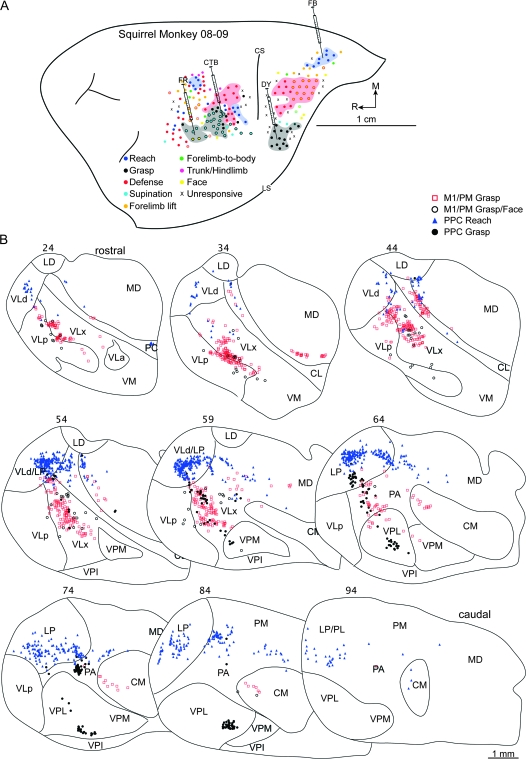Figure 3.
(A) Map of multijoint forelimb movements evoked with intracortical electrical stimulation (0.2-ms biphasic current trains delivered at 300 Hz for 500 ms) from squirrel monkey case 08-09. Microelectrode penetration sites are color coded to reflect evoked movements. Sites that evoked dual movements are represented in 2 colors derived from the color code in the figure legend. Major functional zones are highlighted. M1/PM was mostly characterized by reach, defense, grasp/wrist supination zones, organized from caudal to rostral. The 3 zones shared borders. Rostral and medial to M1 was another reach zone. At the same rostral extent, but lateral, was another grasp zone that included sites of concurrent wrist supination or mouth opening. In PPC, zones of reach, defense, and grasp were organized in a caudomedial to rostrolateral progression. The defense zone involved forelimb movements, but aggressive face gesturers were evoked from the caudal half of this functional zone. Reach and defense zones were separated by sites that evoked forelimb-lift responses, whereas the defense and grasp zones were separated by sites that evoked forelimb supination, face movements, and unresponsive sites. Four retrograde tracers were injected: CTB into M1/PM grasp zone, FR into M1/PM near sites that evoked concurrent grasping and mouth opening, FB into PPC reach zone, and DY into the PPC grasp zone. Major landmarks include lateral sulcus (LS) and central sulcus (CS). (B) Distributions of labeled cells in a series of coronal thalamic sections from the same case. Sections were cut at 40 μm, and the ascending section numbers are organized from rostral to caudal. Each symbol represents a single cell labeled by 1 of the 4 retrograde tracers. Borders of thalamic nuclei were identified from architectonic analysis in adjacent sections.

